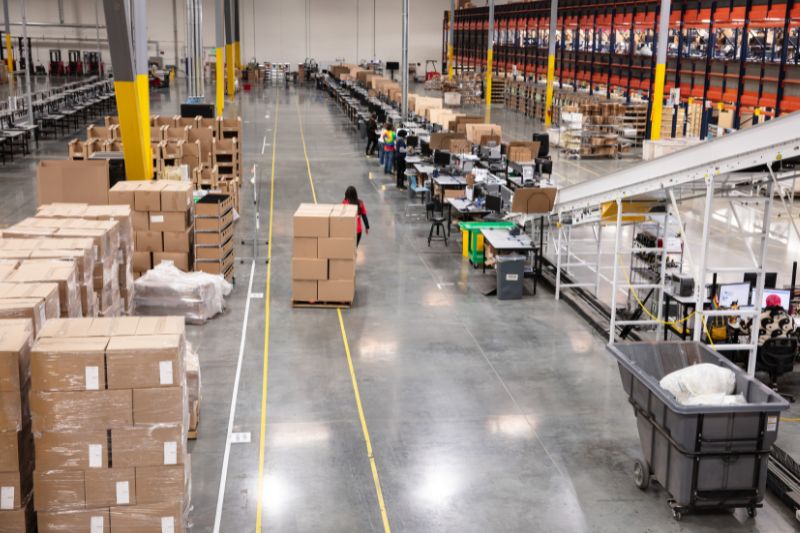Table of Contents
Ideal Fulfillment shares the importance of outsourcing your subscription box business and all of the financial benefits of third-party fulfillment.
The subscription businessmodel has exploded in recent years, offering consumers a convenient and often personalized way to receive products on a recurring basis. From beauty products and gourmet foods to fitness gear and gaming merchandise, subscription boxes have evolved from a niche trend to a mainstream retail strategy. However, running a successful subscription business comes with its fair share of challenges, particularly in managing operational costs while maintaining profitability. For many subscription box companies, third-party fulfillment services, like Ideal Fulfillment, offer a strategic solution to reduce overhead, streamline operations, and maximize financial efficiency.
In this post, we’ll explore how third-party fulfillment can be a game changer for subscription businesses looking to reduce operational costs, boost profitability, and focus on growth. We’ll examine the specific financial benefits that third-party fulfillment can provide and highlight how it can help businesses scale more effectively.

The Subscription Business Model and Its Challenges
The subscription business model is unique in that it relies on recurring revenue generated from customers who commit to regular deliveries of products, typically on a monthly or quarterly basis. While this model can create consistent cash flow and customer loyalty, it also presents operational challenges that can strain a business’s resources.
Key operational challenges faced by subscription businesses include:
- Inventory Management: Balancing inventory to meet customer demand without overstocking can be difficult, especially with the variability in subscriptions, seasonal shifts, and product trends.
- Logistics and Shipping: Efficiently packaging and shipping a large volume of orders on a recurring basis is labor-intensive and costly.
- Customization and Kitting: Many subscription boxes require custom kitting and assembly, which adds complexity and time to the fulfillment process.
- Customer Expectations: As the subscription box industry grows, so do consumer expectations for fast shipping, personalized experiences, and consistent quality.
These challenges often lead to increased operational costs, especially for businesses that manage fulfillment in-house. Whether it’s hiring staff, maintaining warehouse space, or handling shipping logistics, the expenses can quickly eat into a company’s margins. This is where third-party fulfillment services can play a pivotal role in reducing costs and improving financial performance.
What Is Third-Party Fulfillment?
Third-party fulfillment (3PL) is a service that manages the storage, packaging, and shipping of products on behalf of a business. For subscription box companies, like Ideal Fulfillment, this means outsourcing the entire fulfillment process to a specialized provider. Instead of handling inventory management, packing, and shipping in-house, businesses can rely on third-party fulfillment partners to take care of these tasks.
Third-party fulfillment providers typically offer a range of services, including:
- Warehousing and Storage: Storing inventory in strategically located warehouses to optimize delivery times and reduce shipping costs.
- Order Processing and Kitting: Picking, packing, and assembling products according to the business’s specifications, ensuring accurate and customized shipments.
- Shipping and Delivery: Managing relationships with shipping carriers and ensuring orders are delivered to customers in a timely manner.
- Inventory Management: Providing real-time tracking and reporting on stock levels, helping businesses avoid overstocking or stockouts.
Outsourcing fulfillment can provide a significant competitive advantage by allowing businesses to focus on core activities, such as product development, marketing, and customer service while reducing operational costs and improving overall efficiency. Therefore, there are many financial benefits of third-party fulfillment companies.
Financial Benefits of Third-Party Fulfillment for Subscription Businesses
There are many wonderful financial benefits of third-party fulfillment companies for subscription box businesses.
- Reduction in Labor Costs
One of the most significant expenses for subscription businesses is labor. Fulfilling subscription boxes is labor-intensive, requiring staff to pick, pack, assemble, and ship orders on a recurring basis. This can become especially costly as a business grows and the volume of orders increases. Hiring and training employees, managing payroll, and providing benefits can quickly become a financial burden.
By outsourcing fulfillment to a third-party provider, businesses can significantly reduce their labor costs. Third-party fulfillment centers are already staffed with trained personnel who specialize in order processing, kitting, and shipping. This eliminates the need for subscription businesses to hire and manage their own fulfillment teams, resulting in substantial savings.
Additionally, third-party providers often leverage advanced automation technologies, such as robotics and software systems, to further streamline the fulfillment process. This automation reduces the need for manual labor, leading to faster and more accurate order processing at a lower cost.
- Lower Warehousing and Storage Costs
Another major operational cost for subscription businesses is warehousing and storage. Maintaining a warehouse space, whether owned or rented, comes with fixed costs such as rent, utilities, and insurance. As a subscription business grows and requires more storage space, these costs can escalate quickly.
Third-party fulfillment providers offer a more cost-effective solution by providing warehousing as part of their services. These providers typically operate multiple warehouses across different regions, allowing subscription businesses to store their inventory in strategic locations. This not only reduces the need for businesses to invest in their own storage space but also optimizes shipping costs by reducing the distance between the warehouse and the customer.
Additionally, third-party fulfillment providers often use shared warehousing models, where multiple clients share the same warehouse space. This further reduces storage costs for each individual business, as the expenses are spread across multiple users. This is one of the many financial benefits of third-party fulfillment centers.
- Reduced Shipping Costs
Shipping is a significant cost for subscription businesses, especially as consumers increasingly expect fast and affordable delivery. Managing shipping logistics in-house can be both time-consuming and expensive, particularly for smaller businesses that lack the negotiating power to secure discounted shipping rates from carriers.
Third-party fulfillment providers, on the other hand, often have established relationships with major shipping carriers and can negotiate bulk shipping discounts that individual businesses would not be able to secure on their own. These discounts are passed on to the subscription business, resulting in lower shipping costs for each order.
Additionally, third-party providers often have multiple fulfillment centers located in different regions, which allows them to distribute inventory closer to the end customer. This reduces shipping distances and times, further lowering shipping costs while improving delivery speed. For subscription businesses, this means not only saving money but also meeting customer expectations for timely delivery, which can lead to higher retention rates and customer satisfaction.
- Improved Inventory Management and Reduced Overhead
Effective inventory management is critical for subscription businesses, as overstocking or running out of products can lead to increased costs and lost sales. However, managing inventory in-house can be challenging, particularly for subscription businesses that deal with seasonal fluctuations, limited-edition products, or customized orders.
Third-party fulfillment providers offer advanced inventory management systems that provide real-time visibility into stock levels. This allows subscription businesses to monitor their inventory more accurately and make informed decisions about when to reorder products or adjust their subscription offerings. By optimizing inventory levels, businesses can reduce the costs associated with overstocking, such as excess storage fees or unsold products, while minimizing the risk of stockouts that could lead to lost revenue.
Additionally, third-party fulfillment providers often offer demand forecasting and inventory optimization tools that help subscription businesses anticipate future needs based on historical data and trends. This proactive approach to inventory management can reduce the need for emergency restocking, which can be costly and disruptive to operations.
- Scalability Without the Financial Burden
One of the key advantages of third-party fulfillment for subscription businesses is scalability. As a subscription business grows, the volume of orders can increase rapidly and it is important to understand the financial benefits of third-party fulfillment. Scaling in-house fulfillment operations to accommodate this growth often requires significant financial investment in additional staff, warehouse space, and equipment.
Third-party fulfillment providers are built to scale alongside their clients. They have the infrastructure, technology, and personnel to handle increased order volumes without requiring the subscription business to make costly investments. Whether a business is fulfilling 100 orders a month or 10,000, a third-party fulfillment provider can scale operations seamlessly, allowing the business to grow without incurring significant overhead costs.
This scalability is particularly beneficial for subscription businesses that experience seasonal spikes in demand or offer limited-edition boxes that generate sudden surges in orders. Instead of scrambling to expand in-house operations to meet these fluctuations, businesses can rely on their fulfillment partner to handle the increased volume efficiently and cost-effectively.
- Focus on Core Business Activities
For subscription businesses, time is money. Managing fulfillment in-house can be incredibly time-consuming, diverting resources away from core business activities such as product development, marketing, and customer service. This can limit a company’s ability to innovate, engage customers, and ultimately drive growth.
By outsourcing fulfillment to a third-party provider, subscription businesses can free up valuable time and resources to focus on what they do best—curating unique products, creating engaging content, and building strong customer relationships. This shift in focus can lead to increased revenue, as businesses are able to invest more time in activities that directly contribute to growth and profitability.
In addition to freeing up time, third-party fulfillment providers also offer expertise in logistics and supply chain management that many subscription businesses may lack in-house. This expertise can lead to more efficient operations, reduced costs, and improved overall performance.
- Reduced Risk and Financial Flexibility
Running fulfillment operations in-house comes with inherent risks, such as equipment breakdowns, staffing shortages, and unexpected disruptions in the supply chain. These risks can lead to costly delays, missed shipments, and ultimately dissatisfied customers.
By outsourcing fulfillment to a third-party provider, subscription businesses can mitigate many of these risks. These are just a few of the benefits of third-party fulfillment companies. Third-party providers typically have contingency plans in place to handle disruptions, such as backup facilities, additional staff, and alternative shipping options. This reduces the likelihood of delays and ensures that orders are fulfilled on time, even in the face of unexpected challenges.
Additionally, outsourcing fulfillment offers subscription businesses greater financial flexibility. Instead of investing in fixed assets such as warehouse space and fulfillment equipment, businesses can operate with a variable cost structure that adjusts based on order volume. This allows for more predictable and manageable expenses, particularly during periods of growth or uncertainty.

The Financial Benefits of Third-Party Fulfillment
For subscription businesses, reducing operational costs is essential to maintaining profitability and long-term success. Third-party fulfillment offers a strategic solution to minimize labor, warehousing, and shipping expenses, while also providing scalability, improved inventory management, and financial flexibility. Therefore there are several financial benefits of third-party fulfillment centers.
By outsourcing fulfillment to companies like Ideal Fulfillmentwe can focus on core activities that drive growth and revenue, such as product development, marketing, and customer engagement. The financial benefits of third-party fulfillment are clear: lower operational costs, increased efficiency, and the ability to scale without the burden of significant overhead.
In an increasingly competitive subscription box market, businesses that leverage third-party fulfillment to reduce costs and streamline operations will be better positioned to achieve sustainable growth and profitability. Whether you’re just starting out or looking to scale, third-party fulfillment can provide the financial edge needed to succeed in the subscription business model.